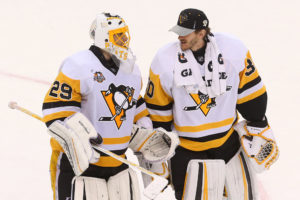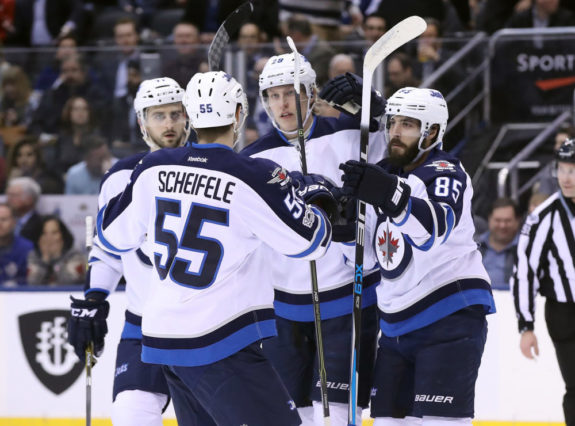The Pittsburgh Penguins are your 2016-17 Stanley Cup champions. It’s not exactly a surprise, but it was unlikely. The last repeat champion was the Detroit Red Wings back in 1997-98.
The National Hockey League is known to be a ‘copycat’ league. Whichever team takes home the Stanley Cup ends up becoming the blueprint for other teams.
This year, the Penguins won it with depth, speed, and just a bit of luck. The Penguins won it last year using the same strategy. NHL teams will be looking to match the Pens now, and that includes the Winnipeg Jets.
The Jets weren’t able to make the playoffs this year, but finished on a high note, winning seven straight to close out the season. Another year of development for their young stars will only help them, and you can expect the Jets to push for the playoffs this coming season (as long as the goaltending is better).
But in a copycat league like the NHL, how to the current Jets stack up against the current Penguins?
Basic Statistics
The Penguins led the NHL in goals for this past season. Sidney Crosby led the league in goals while Evgeni Malkin finished 14th in points. While not as potent as the Pens’ offense, the Jets were no slouches either. With 246 goals, they finished seventh in the league, while four Jets players broke the 60-point plateau (Blake Wheeler, Mark Scheifele, Patrik Laine, and Nikolaj Ehlers).
On the other side of the ice, the Jets struggled to keep the puck out of the net, allowing 255 goals, averaging 3.11 goals against per game. The Penguins didn’t have a wall behind them, but fared better, only allowing 229. That’s an extra goal allowed by the Jets every three games.
Special teams killed the Jets all year. They took a high number of penalties and couldn’t capitalize on their power play. The Jets finished at 18.2 percent with the extra man while only killing off 77.5 percent of their penalties. The Penguins finished third at 23.1 percent on the power play, while the penalty kill struggled at 79.8 percent.
The Jets can match the offensive firepower of the Penguins, but the special teams are really hurting them. Cleaning up the power play and penalty kill will go a long way.
Advanced Statistics
The Penguins were surprisingly bad at possessing the puck through the regular season. They finished with a Corsi-for percentage of 49.97 in close games. However, their best players had the puck when it mattered, with Crosby, Malkin and Kris Letang all over 52 percent.
Possession wins games, and the Jets were even worse than the Penguins. At 48.46 percent, the Jets ranked 21st in the NHL in Corsi Close. The Jets had four significant players over 50 percent, but their best forward and best defenseman were both under. All-Star rookie Patrik Laine finished at 47.40 percent.
The Jets have been a good possession team in the past and it’s possible they just need a year to mature. The youth influx may have been what dragged the percentage down. Plus, the Penguins proved you don’t need to have the puck constantly. But it helps.
Depth
Depth was a big reason the Penguins ended up winning the Stanley Cup this year. With major injuries all over, including Matt Murray getting injured before the playoffs and having no Letang, the Pens were able to put together a winning team with highly skilled players up front and relentless players filling in the gaps.

The defense was held together with duct tape but was able to get the job done. Maybe the most important part of this was their goaltending, which included two bonafide number-one goaltenders in Murray and Marc-Andre Fleury.
On the offensive end, the Jets have plenty of depth—so much that they will lose a good player in the expansion draft. Whether it’s Adam Lowry, Joel Armia, Mathieu Perreault, or Marko Dano, no one is quite sure. Don’t worry, Jets fans; they still have Jack Roslovic and Kyle Connor on the Manitoba Moose, and they can move Nic Petan up in the lineup, or play Dano for more than 38 games next season.
The defensive depth, much like the Penguins, was held together with duct tape. Unfortunately, that duct tape broke and everything fell apart. It doesn’t help when you’re missing Jacob Trouba, Tyler Myers, Tobias Enstrom and Ben Chiarot all at the same time, but the help that arrived just wasn’t good enough to compete daily in the NHL. The good news for the Jets is the potential arrival of Tucker Poolman and Logan Stanley, plus the ability to shore up the left side in this year’s draft with a player like Juuso Valimaki.
The Jets’ goaltending was a disaster last season, plain and simple. However, Connor Hellebuyck still has big potential, plus they have Eric Comrie. The depth isn’t bad, but the experience isn’t there yet.
In terms of depth, the Jets have a lot, equalling (and even exceeding) the Penguins’ depth. The difference now is experience and age. And fewer injuries.
Speed
Ummm…
I rest my case.
The Penguins are a very fast team. That was on display throughout the playoffs, specifically on the penalty kill, where they gave the Predators fits trying to set up. But if there was a team in the NHL that could match that speed, it would be the team with Nikolaj Ehlers, Blake Wheeler, and Josh Morrissey.
Goaltending
This is where is falls apart for the Jets, as I said earlier. The goaltending was not good enough this past year.
The Jets used three main goaltenders and none finished with a save percentage higher than .907. On the contrary, the Penguins used two goaltenders and Fleury finished at .909 while Murray had a .923 save percentage.
The Jets have Comrie waiting with the Moose, while another year should help Hellebuyck. If they want to make a splash, adding the very goaltender that will be leaving the Penguins would be an option. That would shore up the depth while making the Jets competitive next season.
If it’s not Fleury, the Jets should look at adding a veteran goalie to help transition Hellebuyck into full-time duties.
Luck
The beauty of the NHL is the uncertainty. In other sports, a top team will win every game, with few questions asked. In hockey, every game is a contest. Just one bounce, one mistake, or a hot goaltender can completely steal the game. Just ask the Nashville Predators.

The Penguins had luck in the season and that continued right through to the playoffs. PDO is a measure of save percentage and shooting percentage added together. A standard PDO is 100, since league-wide shooting percentage and save percentage should theoretically add up to 1.000. If your PDO is higher, you’ve probably gotten lucky with either your shooting percentage, save percentage, or both. If it’s lower, you’ve been unlucky.
*Writer’s note: PDO is not a perfect measure, but considering luck is not something that can scientifically be measured, it’s the best thing we have.
The Penguins were one of the luckier teams in the league, riding a hot shooting percentage and hot goaltender through the season, finishing at 101.2. The Jets finished at 99.9 with a bad save percentage, but a high shooting percentage. The luck carried over for the Pens in the playoffs, with a PDO of 101.9.
Obviously, luck is not something you can count on. But the old phrase, ‘you have to be good to be lucky’ may apply here. The Jets weren’t good enough last year, then the bounces didn’t go their way, and that helped to keep them out of the playoffs.
The Jets don’t have Sidney Crosby, but they do have some incredible star power in Scheifele, Laine, and Ehlers. They aren’t far off the blueprint of the Penguins, which means they are on the right track. It feels like beating a dead horse to say they need to fix the goaltending, but they look good otherwise.
Pittsburgh gets to celebrate a Stanley Cup win this season, but it’s more and more likely that Winnipeg will get their Stanley Cup parade in the next few years. They just need to continue to follow the blueprint that the Penguins and the Chicago Blackhawks have laid out.